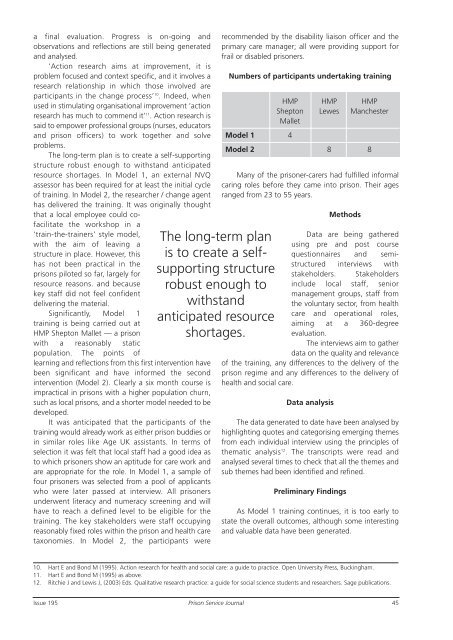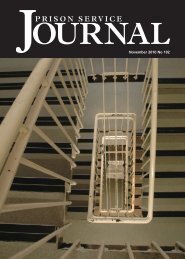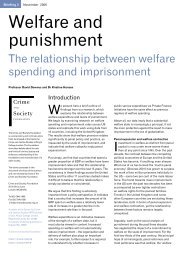Focus on Disability
Focus on Disability
Focus on Disability
You also want an ePaper? Increase the reach of your titles
YUMPU automatically turns print PDFs into web optimized ePapers that Google loves.
a final evaluati<strong>on</strong>. Progress is <strong>on</strong>-going and<br />
observati<strong>on</strong>s and reflecti<strong>on</strong>s are still being generated<br />
and analysed.<br />
‘Acti<strong>on</strong> research aims at improvement, it is<br />
problem focused and c<strong>on</strong>text specific, and it involves a<br />
research relati<strong>on</strong>ship in which those involved are<br />
participants in the change process’ 10 . Indeed, when<br />
used in stimulating organisati<strong>on</strong>al improvement ‘acti<strong>on</strong><br />
research has much to commend it’ 11 . Acti<strong>on</strong> research is<br />
said to empower professi<strong>on</strong>al groups (nurses, educators<br />
and pris<strong>on</strong> officers) to work together and solve<br />
problems.<br />
The l<strong>on</strong>g-term plan is to create a self-supporting<br />
structure robust enough to withstand anticipated<br />
resource shortages. In Model 1, an external NVQ<br />
assessor has been required for at least the initial cycle<br />
of training. In Model 2, the researcher / change agent<br />
has delivered the training. It was originally thought<br />
that a local employee could cofacilitate<br />
the workshop in a<br />
‘train-the-trainers’ style model,<br />
with the aim of leaving a<br />
structure in place. However, this<br />
has not been practical in the<br />
pris<strong>on</strong>s piloted so far, largely for<br />
resource reas<strong>on</strong>s. and because<br />
key staff did not feel c<strong>on</strong>fident<br />
delivering the material.<br />
Significantly, Model 1<br />
training is being carried out at<br />
HMP Shept<strong>on</strong> Mallet — a pris<strong>on</strong><br />
with a reas<strong>on</strong>ably static<br />
populati<strong>on</strong>. The points of<br />
learning and reflecti<strong>on</strong>s from this first interventi<strong>on</strong> have<br />
been significant and have informed the sec<strong>on</strong>d<br />
interventi<strong>on</strong> (Model 2). Clearly a six m<strong>on</strong>th course is<br />
impractical in pris<strong>on</strong>s with a higher populati<strong>on</strong> churn,<br />
such as local pris<strong>on</strong>s, and a shorter model needed to be<br />
developed.<br />
It was anticipated that the participants of the<br />
training would already work as either pris<strong>on</strong> buddies or<br />
in similar roles like Age UK assistants. In terms of<br />
selecti<strong>on</strong> it was felt that local staff had a good idea as<br />
to which pris<strong>on</strong>ers show an aptitude for care work and<br />
are appropriate for the role. In Model 1, a sample of<br />
four pris<strong>on</strong>ers was selected from a pool of applicants<br />
who were later passed at interview. All pris<strong>on</strong>ers<br />
underwent literacy and numeracy screening and will<br />
have to reach a defined level to be eligible for the<br />
training. The key stakeholders were staff occupying<br />
reas<strong>on</strong>ably fixed roles within the pris<strong>on</strong> and health care<br />
tax<strong>on</strong>omies. In Model 2, the participants were<br />
recommended by the disability liais<strong>on</strong> officer and the<br />
primary care manager; all were providing support for<br />
frail or disabled pris<strong>on</strong>ers.<br />
Numbers of participants undertaking training<br />
Model 1 4<br />
The l<strong>on</strong>g-term plan<br />
is to create a selfsupporting<br />
structure<br />
robust enough to<br />
withstand<br />
anticipated resource<br />
shortages.<br />
HMP HMP HMP<br />
Shept<strong>on</strong> Lewes Manchester<br />
Mallet<br />
Model 2 8 8<br />
Many of the pris<strong>on</strong>er-carers had fulfilled informal<br />
caring roles before they came into pris<strong>on</strong>. Their ages<br />
ranged from 23 to 55 years.<br />
Methods<br />
Data are being gathered<br />
using pre and post course<br />
questi<strong>on</strong>naires and semistructured<br />
interviews with<br />
stakeholders. Stakeholders<br />
include local staff, senior<br />
management groups, staff from<br />
the voluntary sector, from health<br />
care and operati<strong>on</strong>al roles,<br />
aiming at a 360-degree<br />
evaluati<strong>on</strong>.<br />
The interviews aim to gather<br />
data <strong>on</strong> the quality and relevance<br />
of the training, any differences to the delivery of the<br />
pris<strong>on</strong> regime and any differences to the delivery of<br />
health and social care.<br />
Data analysis<br />
The data generated to date have been analysed by<br />
highlighting quotes and categorising emerging themes<br />
from each individual interview using the principles of<br />
thematic analysis 12 . The transcripts were read and<br />
analysed several times to check that all the themes and<br />
sub themes had been identified and refined.<br />
Preliminary Findings<br />
As Model 1 training c<strong>on</strong>tinues, it is too early to<br />
state the overall outcomes, although some interesting<br />
and valuable data have been generated.<br />
10. Hart E and B<strong>on</strong>d M (1995). Acti<strong>on</strong> research for health and social care: a guide to practice. Open University Press, Buckingham.<br />
11. Hart E and B<strong>on</strong>d M (1995) as above.<br />
12. Ritchie J and Lewis J, (2003) Eds. Qualitative research practice: a guide for social science students and researchers. Sage publicati<strong>on</strong>s.<br />
Issue 195 Pris<strong>on</strong> Service Journal<br />
45











